Migrating Whooping Crane Activity Near U.S. Air Force Bases and Airfields in Oklahoma
Links
- Document: Report (17 MB pdf) , HTML , XML
- Data Releases:
- USGS data release - Location data for whooping cranes of the Aransas-Wood Buffalo Population, 2009–2018
- USGS data release - Whooping crane use around Air Force Bases in Oklahoma, 2017–2022
- Download citation as: RIS | Dublin Core
Acknowledgments
Logistical, financial, and administrative support for capture of whooping cranes and data collection were provided by the Canadian Wildlife Service, U.S. Fish and Wildlife Service, U.S. Geological Survey, Parks Canada, and the International Crane Foundation. The U.S. Air Force provided the funds to summarize the data presented in this report. We thank the U.S. Fish and Wildlife Service Nebraska Ecological Services office for use of the whooping crane public sightings database to assess whooping crane group size and the identity and frequency of other birds observed with whooping cranes.
Abstract
The Aransas-Wood Buffalo population of Grus americana (Linnaeus, 1758; whooping cranes) migrates through the U.S. Great Plains, encountering places substantially altered by human activity. Using telemetry data from 2017 to 2022, we investigated whooping crane migration behavior around U.S. Air Force bases in Oklahoma. Our study focused on potential collision risks between whooping cranes and aircraft, a substantial concern for aviation safety. We determined that activity was greatest at Kegelman Air Force Auxiliary Airfield, near whooping crane critical habitat. On average, 61 percent of marked whooping cranes used locations west of Kegelman Air Force Auxiliary Airfield and Vance Air Force Base during autumn migration and 55 percent during spring migration, and few cranes approached within 5 kilometers of airfields. Flight characteristics revealed seasonal variations in altitude and timing; cranes flew at lower altitudes in autumn and had distinct flight patterns. Additionally, we assessed temporal aspects of migration, identifying average arrival and departure dates for spring and autumn migrations. Cranes indicated consistency in seasonal presence, which may aid in risk assessments. Our findings underscore the importance of monitoring potential interactions between whooping cranes and aircraft, particularly around whooping crane critical habitat like the Salt Plains National Wildlife Refuge in Oklahoma. Detailed summaries of migration patterns and flight behavior can be used to assist the U.S. Air Force in assessing collision risks and developing mitigation strategies. Furthermore, these summaries can provide insights for the conservation efforts of this endangered species managed by the U.S. Fish and Wildlife Service and serve as a step towards mitigating risks to aviation safety and the recovery of whooping cranes.
Introduction
The Aransas-Wood Buffalo population of Grus americana (Linnaeus, 1758; whooping cranes), an endangered species in the United States and a species at risk in Canada, migrates through the U.S. Great Plains twice annually, moving between wintering sites along coastal Texas and summering sites in and around Wood Buffalo National Park, Canada (Allen, 1952). These birds primarily navigate within a roughly 300-kilometer (km)-wide corridor that spans parts of Texas, Oklahoma, Kansas, Nebraska, South Dakota, North Dakota, and northwestern Montana in the United States, an extensive region substantially altered by urbanization, cultivation, and hydrological changes (Kuyt, 1992; Pearse and others, 2018).
During each migration event, whooping cranes use an average of six stopover sites in the United States, spending an average of 2.5 nights (1–49) at each site, and make occasional daytime stops that likely last between 1 and 2 hours (Pearse and others, 2020b). On average, individual cranes make a single stop in Oklahoma each spring and autumn migration. Throughout migrations, whooping cranes select wetland and upland sites with unobstructed visibility, shallow water depths, and increased distance from human developments because the species is known to be sensitive to disturbance (Howe, 1989; Pearse and others, 2017; Baasch and others, 2019). Conservation efforts involve safeguarding whooping cranes from potential threats and disturbances, as well as managing stopover habitat during migration (Canadian Wildlife Service and U.S. Fish and Wildlife Service, 2007).
The U.S. Air Force (USAF) completes year-round training and operational missions across three bases in Oklahoma (Vance, Altus, and Tinker Air Force Bases [AFBs]). All AFBs are within the migration corridor of the whooping crane. The chance of whooping cranes making a migration stopover near each AFB varies based on location and surrounding available habitat. Whooping cranes have been documented within 20 km of the bases (Pearse and others, 2020a). One installation that is part of Vance AFB, Kegelman Air Force Auxiliary Airfield (hereafter Kegelman Auxiliary Airfield), is within 6 km of the Salt Plains National Wildlife Refuge (NWR), which has been designated as whooping crane critical habitat (U.S. Fish and Wildlife Service, 1978). Of marked whooping cranes, 27 percent stopped in the refuge each migration from 2010 to 2016 (Pearse and others, 2020a).
Collisions with birds pose a persistent hazard for civilian and military aircraft, with potential consequences including financial costs, aircraft loss, and loss of human lives (Sodhi, 2002; Dolbeer and others, 2023). Collisions with large-bodied birds, such as whooping cranes, can result in substantial damage to aircraft and elevate the collision risk to humans and aircraft. Most bird strikes are at low altitudes (less than 300 meters [m]) and at airfields during takeoff or landing (Dolbeer, 2006). One suspected case of an aircraft and whooping crane collision involving a military tanker aircraft was documented in South Dakota in 1982 (Stehn and Haralson-Strobel, 2014). Although no collisions have been documented in Oklahoma, the increasing number of whooping cranes in the population raises collision risk, especially at locations attracting large numbers of whooping cranes during migration, like the Salt Plains NWR.
Interactions between whooping cranes and military aircraft pose risks to the USAF and whooping crane species recovery. Limited information is available regarding whooping crane use of locations surrounding AFBs in Oklahoma. Concurrently, ongoing research efforts on whooping cranes aim to provide insights into migration flight altitudes and pathways. This information can be used by the USAF to assess potential risks to aircraft and pilots and the U.S. Fish and Wildlife Service (USFWS) to evaluate any potential threats to the recovery of this endangered species. Our objective was to summarize data that could be used by the USAF to assess potential for aircraft-crane collision risk and the USFWS to determine potential risk to whooping cranes related to activities at AFBs. The summaries presented in this report include identifying temporal patterns of potential encounters, spatial patterns of use surrounding bases and regionally, and use of airspace by flying whooping cranes.
Background and Study Area
The USAF operates three bases in Oklahoma within the migration corridor of the whooping crane (fig. 1). The region is in the southern part of the Great Plains, a vast grassland ecosystem covering 1.3 million square kilometers across central North America. The primary base of interest for this report, Vance AFB, operates two active airfields in northern Oklahoma (fig. 2). The primary airfield is near the city of Enid, Oklahoma, and a secondary one-runway facility, Kegelman Auxiliary Airfield, 48 km northeast of the Enid airfield. Altus AFB is adjacent to the city of Altus in southwestern Oklahoma. Tinker AFB is in Oklahoma City in central Oklahoma. Oklahoma lies within a semiarid region of the United States. The State is characterized by hot summers (the average daily temperature in July is 28.5 degrees Celsius) and cold winters (the average daily temperature in January is 2.1 degrees Celsius). The region receives 76 centimeters of precipitation annually on average, primarily between March and October.
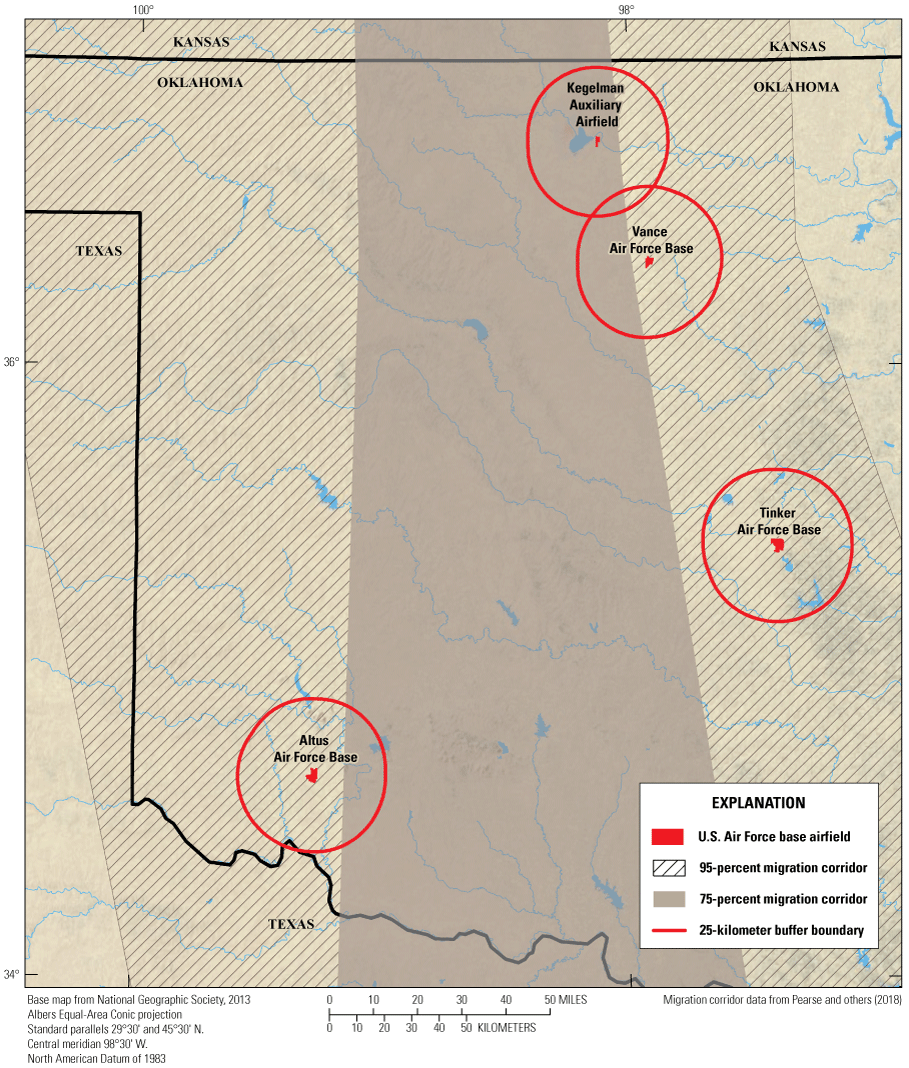
Map showing locations of four U.S. Air Force base airfields within the 95- and 75-percent migration corridors of Grus americana (Linnaeus, 1758; whooping crane) in Oklahoma with 25-kilometer buffered areas.
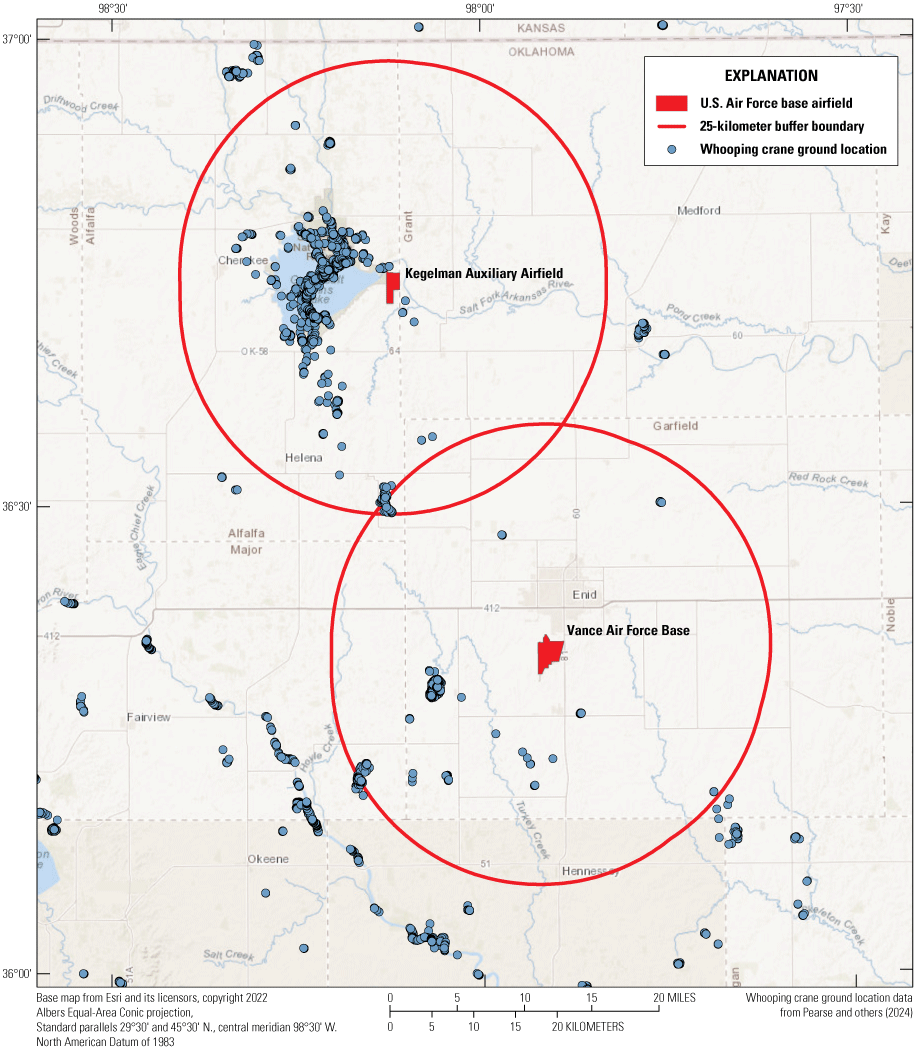
Map showing the ground locations of 79 marked Grus americana (Linnaeus, 1758; whooping cranes) near and within 25-kilometer buffers surrounding the Kegelman Auxiliary Airfield and Vance Air Force Base airfield during their spring and autumn migrations, 2017–22, Oklahoma.
The Great Salt Plains Lake and Salt Plains NWR are west of Kegelman Auxiliary Airfield. The Salt Plains NWR was designated as whooping crane critical habitat in 1978 (U.S. Fish and Wildlife Service, 1978). The Great Salt Plains Lake was formed by a dam on the Salt Fork of the Arkansas River constructed and maintained by the U.S. Army Corps of Engineers. The Salt Plains NWR includes nonvegetated salt flats, open water, salt marshes, and vegetated uplands (Bonner, 2008). Migrating shorebirds, waterfowl, and other waterbirds use the Salt Plains NWR as an important stopover site in the region. Moreover, the refuge attracts breeding Charadrius nivosus (Cassin, 1858; snowy plovers), Sternula antillarum (R. Lesson, 1847; least terns), and other birds (U.S. Fish and Wildlife Service, 2006; Thomas and others, 2012; Heath-Acre and others, 2021).
Methods
We captured and marked 96 whooping cranes from the Aransas-Wood Buffalo population with Global System for Mobile Communications (GSM) transmitters on their breeding grounds in and around Wood Buffalo National Park, Canada, and wintering sites along coastal Texas, 2017–22. Marking and capture activities were completed under multiple State, Provincial, and Federal permits and two animal care and use protocols (see Ellis and others [2022] for more information). GSM transmitters collected location data via the Global Positioning System at a high rate, enabling identification of unique migration pathways and stopover use with high resolution. Integrated three-axis accelerometers detected movement and were coupled with speed calculations to detect when cranes were in flight. Default programming protocols collected locations at 15-minute intervals but, during migration, we programmed transmitters to collect more frequent data collection (as much as 30-second intervals) in flight when battery voltages were sufficient. If battery levels dropped to less than 50 percent, the location data collection rate during flight was reduced to every minute; if battery levels dropped to less than 25 percent, the location data collection rate during flight was reduced to every hour. Nonflight data collection maintained 15-minute intervals within geofences.
Given a lack of exact Area of Operations, places in which most flight operations occur around the Oklahoma AFBs, we buffered the perimeter of each base by 25 km to summarize whooping crane activity within this proximity. This designation created slight overlap of the Kegelman Auxiliary Airfield and Vance AFB airfield (fig. 2). Because of this overlap, these two zones could possibly be considered one contiguous area when considering timing of use. In this report, we summarize them separately for some metrics but combine them for others. All birds that were known to migrate through Oklahoma each year were used in these summaries, but for most data presented, only birds that provided location data within airfield boundaries were used. Data from the Kegelman Auxiliary Airfield and Vance AFB airfield dominate the dataset. The other AFBs provided minimal information but followed similar temporal trends. For indepth summaries, only data from these two airfields are used to minimize misrepresentation based on small sample size. Residency times were calculated for each migration period by taking the first location within the Kegelman Auxiliary Airfield and Vance AFB airfield areas subtracted from the last location within that same area.
We initially classified locations as occurring in flight when instantaneous velocity reader measurements were greater than 2.6 meters per second (Byrne and others, 2017). GSM transmitters derive location data via Global Positioning System, which provides an estimate of altitude above mean sea level. We acquired elevation at each airfield to correct altitudes to estimate above ground level (AGL) metrics (AirNav, LLC, 2023). Vertical accuracy of GSM-based transmitters has been estimated by others to be 3.7 m (standard deviation plus or minus [±] 134.6 m) of measured elevations in open locations and 4.8 m (standard deviation ±151 m) for simulated flight (93 percent of locations were within +22 m overall; Byrne and others, 2017). The large standard deviations were because of outliers, which were also present in our data such that we calculated rates of climb or descent for series of flight locations and removed any that exceeded a probable value of 3.5 meters per second (number of samples [n]=436). We also removed locations that had an AGL value less than −20 m (n=220) or greater than 3,000 m (n=1) for calculations. These filters yielded 16,073 AGL values for birds flying within the Kegelman Auxiliary Airfield and Vance AFB airfield areas suitable for summary. Flight locations were then averaged by bird and day to reduce overweighting because of differences in location frequency between birds.
We used designations of flying and ground locations to identify hours of the day during which each marked whooping crane recorded at least one location in flight. We summarized this information across migration seasons and years to characterize average and annual variation in probability of birds in flight. We denoted locations where migration flights began and ended to summarize arrival and departure metrics within AFB areas.
Results
From 2017 to 2022, 91 marked whooping cranes migrated through Oklahoma, 76 during autumn migration (fig. 3) and 71 during spring migration (fig. 4). Because several birds contributed for multiple years, 157 autumn migrations and 155 spring migrations of marked birds with active transmitters passing through the State.
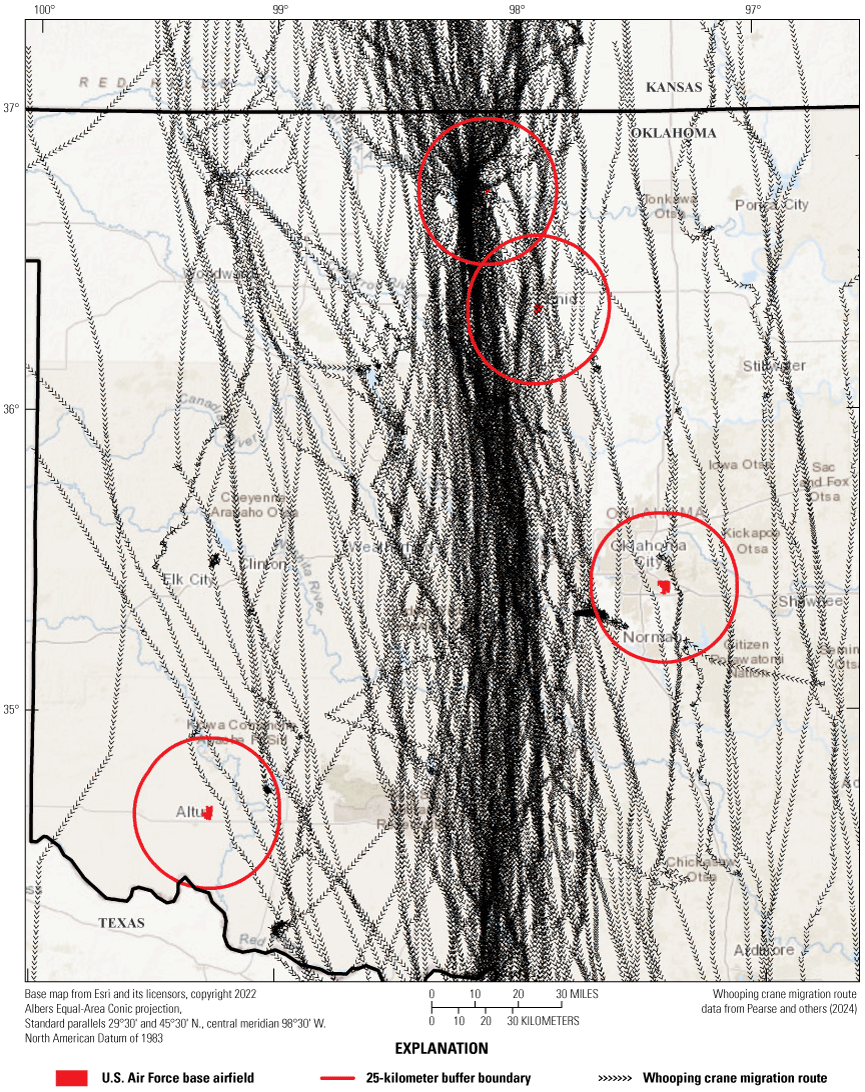
Map showing autumn migration routes of 76 marked Grus americana (Linnaeus, 1758; whooping cranes) through Oklahoma, 2017–22.
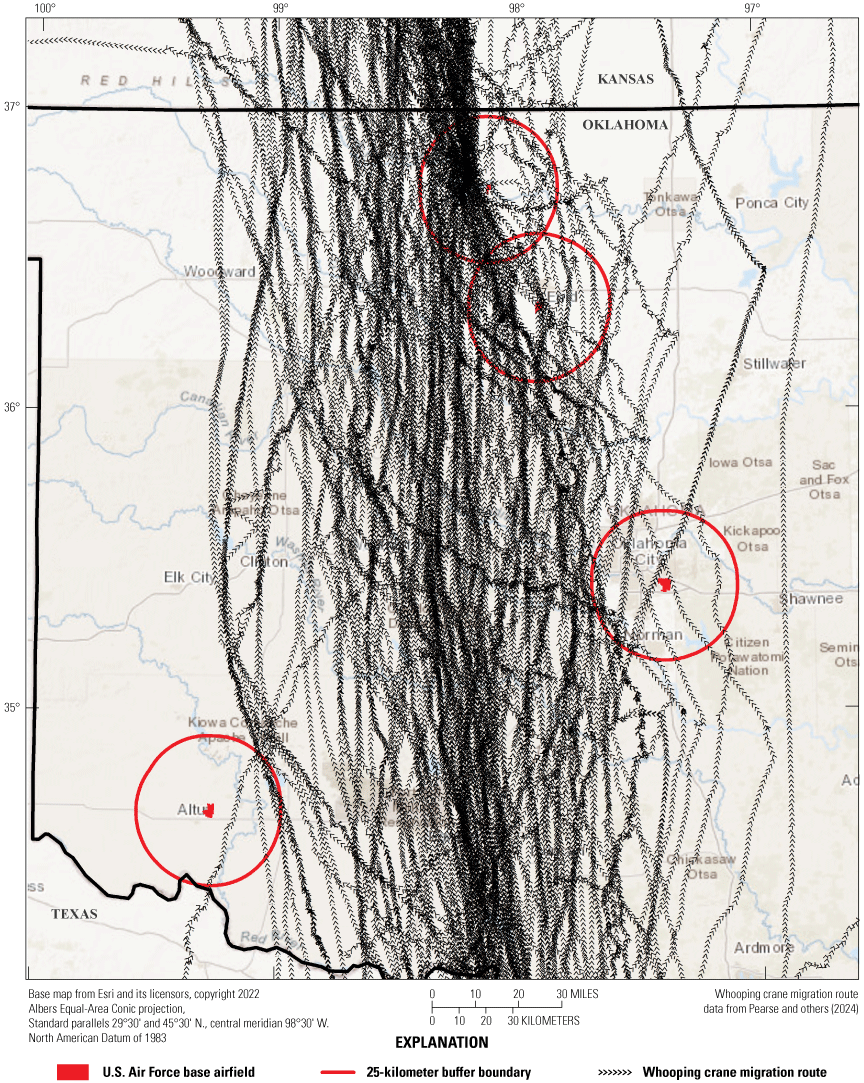
Map showing spring migration routes of 71 marked Grus americana (Linnaeus, 1758; whooping cranes) through Oklahoma, 2018–22.
General Characteristics
Altus AFB.—Three or fewer birds passed through or used the area around this base in any migration season. No marked birds passed through the area in three autumn and two spring seasons. On average, about one bird was detected in the area during each migration season, representing 2 percent or fewer of marked birds during autumn migration and 5 percent or fewer during spring migration (table 1).
Table 1.
Presence of marked Grus americana (Linnaeus, 1758; whooping cranes) within 25 kilometers of four U.S. Air Force base airfields in Oklahoma by during spring and autumn migrations, 2017–22.[Total birds, number of marked birds available to encounter each airfield; AFB, Air Force Base]
Tinker AFB.—The area surrounding this base had a higher number of birds that used or passed through the airspace in later years, concurrent with more birds having active transmitters, but still only represented 19 percent of marked birds during the migration season of maximum use, wherein most birds flew through the area, largely west of the base. On average, twice as many birds used the area during spring migrations compared with autumn migrations (3.2 versus 1.5 birds), representing less than 10 percent of the population of marked birds, on average (table 1).
Kegelman Auxiliary Airfield.—Given this airfield’s proximity to the Salt Plains NWR, the area around this airfield received the most use from marked birds, indicating the highest potential interaction with aircraft. On average, 61 percent of marked whooping cranes either used or passed through this area in autumn, and the proportion of all marked whooping cranes passing through in any autumn migration was between 40 percent in 2017 and 85 percent in 2019 (table 1). Use was also high during spring migrations, for which 55 percent of marked birds used or passed through the area on average. The highest use by marked cranes in spring was 73 percent in 2018 and the lowest was 48 percent in 2021 (table 1).
Most ground use by whooping cranes was 5 km or more west of the airfield in and around the Salt Plains NWR (figs. 2 and 5C). Only four birds were identified using ground locations within 2 km of the airfield (fig. 5C). One bird, 15E, used a cropfield about 600 m northwest of the airfield during the afternoon of October 28, 2020, for about 3 hours (1429–1717) and the morning of October 29, 2020, for 2 hours (0731–0931). Another bird, 8G, used the Salt Fork of the Arkansas River, about 600 m north of the airfield, during the late evening (1815–1915) of March 10, 2021. A cropfield east of the airfield was used for one location by 7F on December 1, 2022, at 0830. Finally, 3J used a cropfield southeast of the airfield on December 1, 2022, for about 20 minutes between 0910 and 0930.
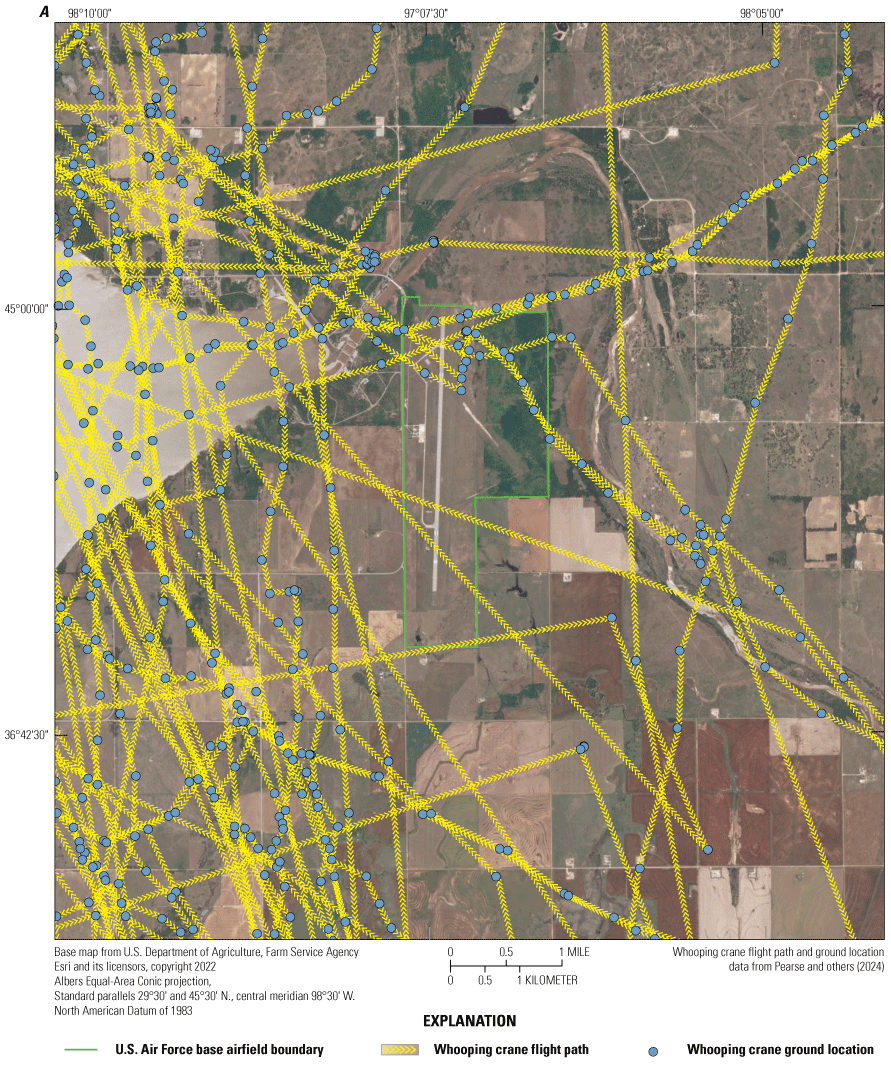
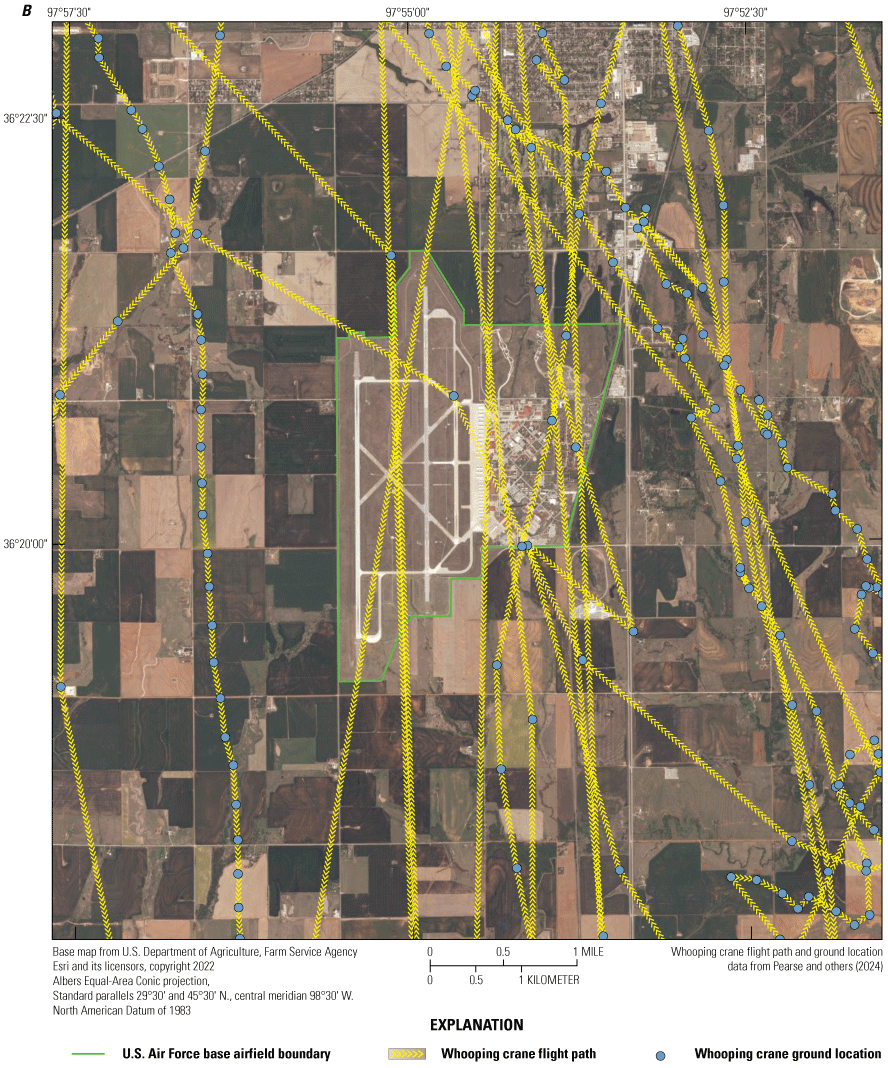
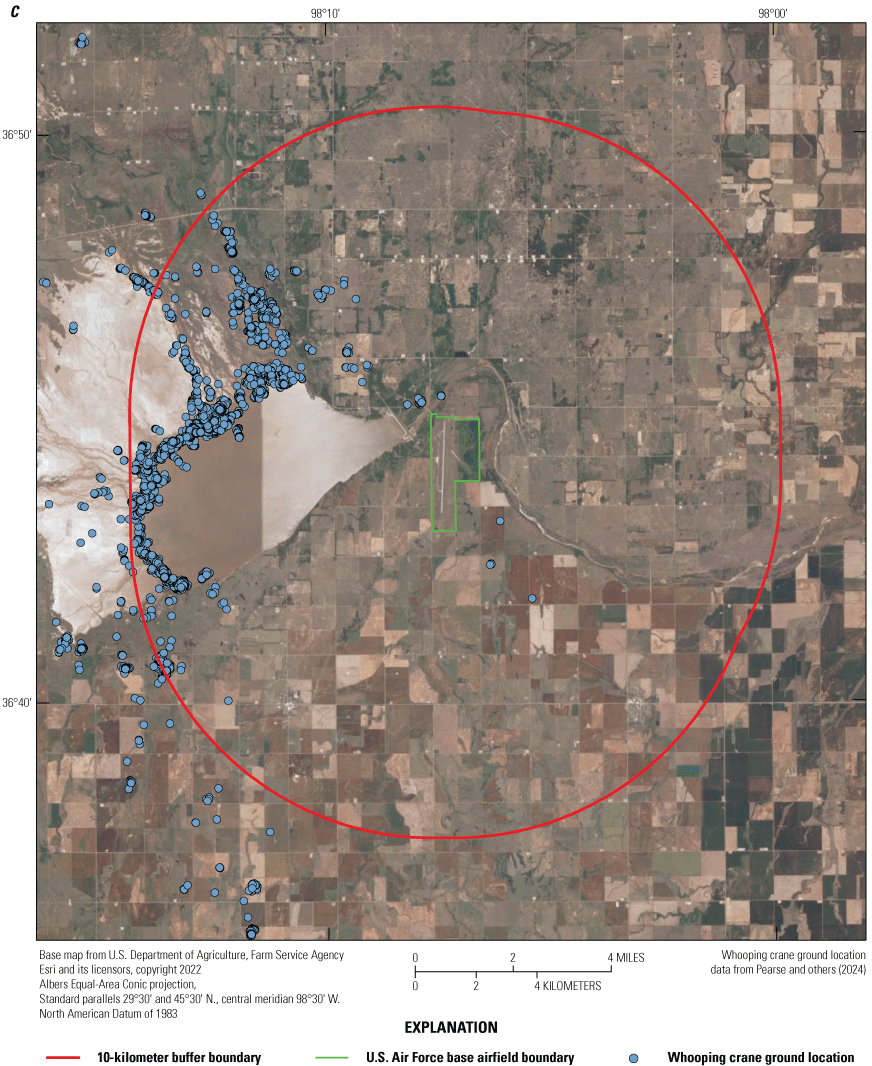
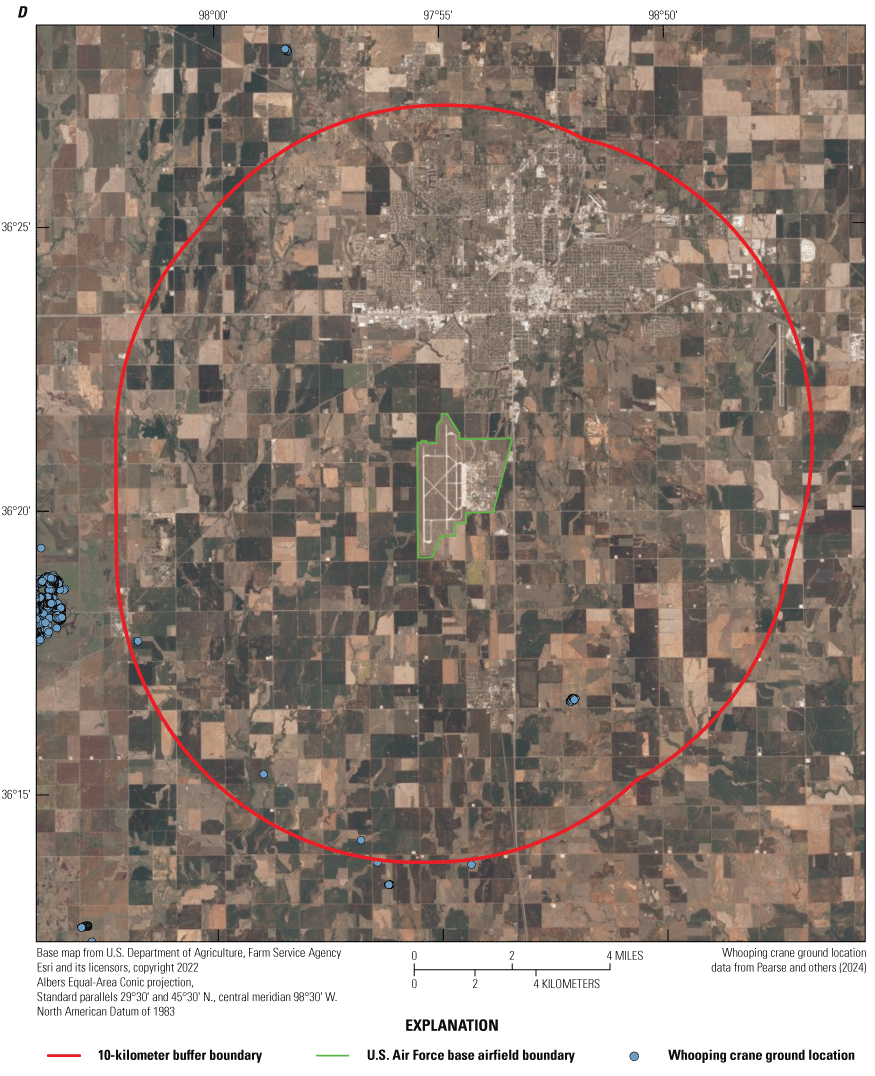
Maps showing the flight paths and ground locations of marked Grus americana (Linnaeus, 1758; whooping cranes) near and within 10-kilometer buffers during their spring and autumn migrations, 2017–22, Oklahoma. A, flight paths around Kegelman Auxiliary Airfield; B, flight paths around Vance Air Force Base airfield; C, ground locations for Kegelman Auxiliary Airfield; D, ground locations for Vance Air Force Base airfield.
Vance AFB.—Because this airfield is southeast of Kegelman Auxiliary Airfield, the amount of whooping crane activity inside the identified area was similarly high. Although overall use was high, few ground observations were made compared with Kegelman Auxiliary Airfield (figs. 2 and 5D), supporting the notion that most use included cranes passing through the area enroute to or departing from the Salt Plains NWR. On average, 42 percent of marked cranes passed through or stopped near Vance AFB airfield in autumn (20–56 percent; table 1). Spring occurrence averaged 34 percent and ranged from 28 percent in 2019 to 41 percent in 2020 (table 1).
Most ground use observed in this area was 12–13 km west of the airfield in a complex of wetlands west of Drummond, Okla. (fig. 2). The closest ground use to the airfield was 6.6 km south. Bird 8H spent the night of March 14, 2022, in wetlands and croplands and left the next morning at 1020 (fig. 5D).
Temporal Aspects of Migration
For all cranes migrating through the State of Oklahoma, the average date of arrival was March 28 for spring migration and November 7 for autumn migration (table 2). The average time they arrived and landed in autumn was 1725, 1.5 hours earlier than that in spring (table 2). This time difference may be related to daylength. Sunset was 1.4 hours earlier on the average dates of arrival in autumn compared to that in spring. Cranes on average arrived from 78 km farther away and spent 1.5 more hours in flight during spring migration, which would also contribute to later arrival. The time of day during which birds began their migration flight to Oklahoma was consistent between seasons (table 2).
Table 2.
Temporal characteristics of migration for 91 Grus americana (Linnaeus, 1758; whooping cranes) migrating through Oklahoma, 2017–22.[Time is given in astronomical format; n, number of samples; TOF, time of flight or duration of migration in hours; min, minimum; max, maximum; AFB, Air Force Base]
For cranes departing Oklahoma, the mean date of departure was March 30 for spring migration and November 8 for autumn migration (table 2). Time of departure was similar between seasons (1019 in spring, 1002 in autumn), even though the sun rises 0.65 hour earlier on mean dates of departure in spring compared with that in autumn (table 2).
For cranes using within 25 kilometers of the Kegelman Auxiliary Airfield and Vance AFB airfield, dates and times of arrival and departure were similar compared to the trends for Oklahoma, but distances and times of flight differed with the difference in spatial extent (table 2). In spring, 90 percent of cranes passed through the Kegelman Auxiliary Airfield and Vance AFB airfield areas between March 11 (5th percentile) and April 18 (95th percentile; fig. 6). In autumn, 90 percent of cranes passed through the Kegelman Auxiliary Airfield and Vance AFB airfield areas between October 24 (5th percentile) and December 3 (95th percentile; fig. 6). Additional summaries of timing of migration by day and hour of day are available in appendix 1.
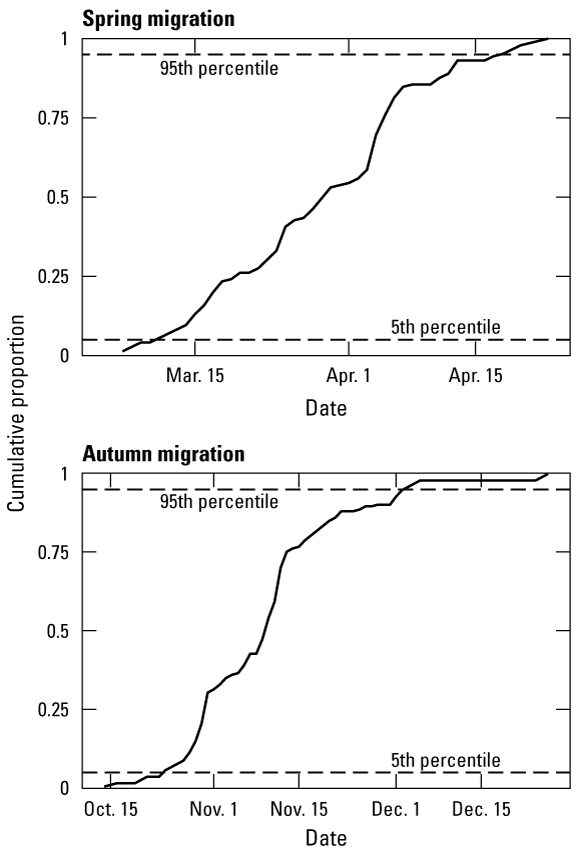
Graphs showing cumulative proportion of Grus americana (Linnaeus, 1758; whooping cranes) within 25 kilometers of the Kegelman Auxiliary Airfield, Oklahoma, during spring and autumn migrations, 2017–22.
Whooping cranes that flew through the Kegelman Auxiliary Airfield and Vance AFB airfield without stopping were in flight within the buffered areas for about 1 hour, on average, during spring and autumn migrations. Birds that stopped and stayed at least 1 night within the area (38 in spring and 49 in autumn, primarily at the Salt Plains NWR) spent, on average, 1.6 days (standard error is ±0.2 day) in spring and 1.3 days (standard error is ±0.1 day) in autumn. The shortest stay was 0.6 day in spring and autumn. The longest stay was 5.7 days in spring and 4.0 days in autumn. In both seasons, only 8 percent of the stopovers were more than 3 days.
Flight Characteristics
The altitude at which cranes fly changes substantially because of the use of dynamic soaring for migration (Pearse and others, 2024). For cranes flying through the areas surrounding airfields, the average altitude above the published elevation for the associated nearest airfield was greater in spring migration (411 m; standard error is ±23 m) than in autumn migration (271 m; standard error is ±17 m]). Average AGL for flying whooping cranes near the Vance AFB airfield was higher than for birds flying near Kegelman Auxiliary Airfield in spring. For Vance AFB in spring, the mean AGL is 601 m and the 95-percent confidence interval is 468–734. For Kegelman Auxiliary Airfield in spring, the mean AGL is 343 m and the 95-percent confidence interval is 255–431. For Vance AFB in autumn, the mean AGL is 324 m and the 95-percent confidence interval is 189–459. For Kegelman Auxiliary Airfield in autumn, the mean AGL is 248 m and the 95-percent confidence interval is 197–299. Confidence intervals of estimates overlapped for birds flying in autumn.
Whooping cranes within 25 km of Kegelman Auxiliary Airfield and Vance AFB airfield were more likely to be in flight between the hours of 1000 and 1700 than other times of the day (fig. 7). In spring, cranes in the area were engaged in flight consistently during the day, and the greatest proportion of cranes was in flight during midday. By contrast, during autumn migration, flight behavior peaked midmorning (1000) and declined steadily as the day progressed.
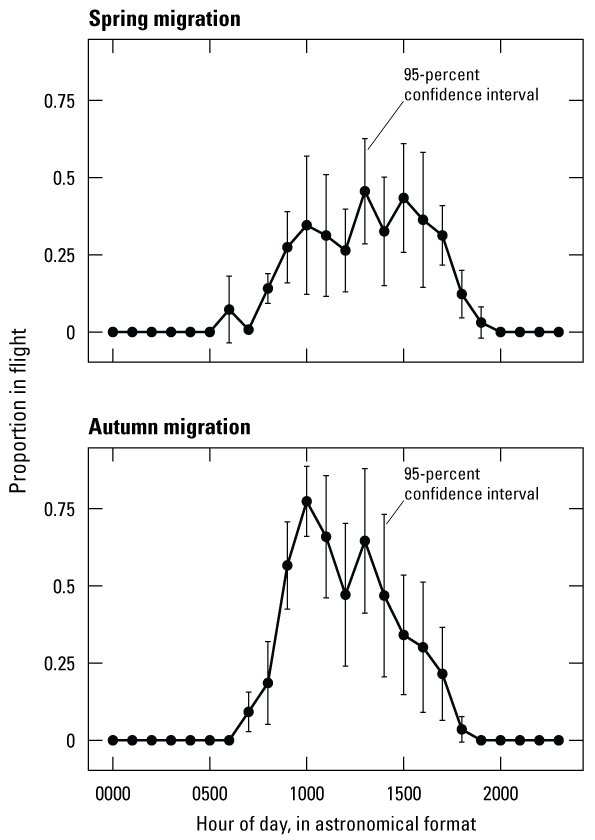
Graphs showing the proportion of Grus americana (Linnaeus, 1758; whooping cranes) that had at least one location in flight within 25 kilometers of the Kegelman Auxiliary Airfield and Vance Air Force Base airfield, Oklahoma, by hour of the day during spring and autumn migrations, 2017–22.
Locations were recorded for four groups of birds as they flew over Kegelman Auxiliary Airfield (fig. 5A). A flight location at 648 m AGL was recorded for bird 6D during spring migration on April 19, 2020, at 1310. Locations were recorded at 186–268 m AGL for birds 10D and 15E on November 11, 2021, at 1655. Bird 5D flew over the airfield at 730 m AGL on November 15, 2022, at 1634. Birds 3J and 7F were flying together at 117–272 m AGL on December 4, 2022, and reached the airfield at 1020.
Locations were recorded for three birds as they flew over the Vance AFB airfield in 2021 and 2022 (fig. 5B). Bird 7C was detected at 502 m AGL on March 24, 2021, at 1137. Later that migration season, bird 13G was flying at 320–939 m AGL over the airfield on April 18, 2021, at 1701–1711. Finally, bird D32 flew at 719–729 m AGL above the airfield on March 14, 2022, at 1410.
Discussion
Over 15 years of study, nearly all tracked whooping cranes of the Aransas-Wood Buffalo population have migrated through the State of Oklahoma (Pearse and others, 2020a, 2024). The migration corridor for this population has been estimated to be at its narrowest when bisecting Oklahoma (Pearse and others, 2018) because the region offers less stopover habitat compared with other parts of the migration corridor (Stahlecker, 1992). Whooping cranes and other thermal soaring migrants, like the Ciconia nigra (Linnaeus, 1758; black stork), have been determined to have high levels of fidelity to their migration corridor but low fidelity to individual stopover sites (Chevallier and others, 2011; Pearse and others, 2020b). The Great Salt Plains Lake, including the Salt Plains NWR, serves as a primary exception to the general pattern of low site fidelity and attracts substantial use by multiple groups of cranes during most migration seasons (Pearse and others, 2020b). The Salt Plains NWR is a reliable resource in a location within the corridor that has little surface water for whooping cranes and other migratory waterbirds compared to the surrounding landscape. Other primary stopover sites for whooping cranes in the region include the Red River on the Oklahoma-Texas border (280 km south of Salt Plains NWR) and the Cheyenne Bottoms Waterfowl Management Area and Quivira NWR in Kansas (whooping crane critical habitat 160 km north of Salt Plains NWR; U.S. Fish and Wildlife Service, 1978). By comparison, relatively few whooping cranes used areas near Altus AFB and Tinker AFB, which are located in the 75-percent migration corridor (fig. 1) and are likely surrounded by less available stopover habitat attractive to migrating whooping cranes. Therefore, we have included information regarding use around Altus AFB and Tinker AFB for completeness, but no further interpretations of use by whooping cranes are made at these locations.
The relative extensive use around Kegelman Auxiliary Airfield compared to other airfields was dominated by activity to the west at the Salt Plains NWR. In contrast, few birds used locations within 2 km of the airfield, and large zones to the south, east, and northeast of the airfield were largely void of use by marked whooping cranes. The Salt Fork of the Arkansas River less than 1 km north of the airfield, where whooping cranes were present, may be a location where collision risk might be greater than other locations. Whooping cranes regularly use rivers for diurnal and nocturnal habitat throughout the migration corridor (Austin and Richert, 2005). The airfield’s proximity to usable riverine habitat at the Salt Fork and the habitat’s location at the end of an active airstrip provide support for a location where future monitoring could take place to document the frequency of any additional use of this reach of river by whooping cranes or other large-bodied waterbirds. Based on data used in this summary, we suspect that this riverine site will receive limited use by whooping cranes because a more preferred site, the Salt Plains NWR, is readily available within a short distance. Nonetheless, collision risk is expected to increase as the population increases in size.
The amount of time cranes were present near Kegelman Auxiliary Airfield and Vance AFB was consistently about 40 days during each migration season. Spring use for most cranes was from mid-March to mid-April and arrivals peaked at the end of March. Autumn use was primarily from late October to early December and arrivals peaked in early November. Although the 25-kilometer area around Kegelman Auxiliary Airfield and Vance AFB was used for about 40 days twice each year, most individual birds stayed for only a short time. For each season, the average dates of arrival and departure were days apart from one another, and cranes stopping in the area resided for an average of about 1.5 days. Most birds moved through the area quickly, and only 8 percent of cranes stayed for 3 days or more. This magnitude of residency corresponds with other stopover sites in the migratory corridor, except use of parts of Saskatchewan in autumn, when many birds stay for weeks (Pearse and others, 2020b). Because of this short residency and high turnover of birds using the area, individuals would have little time for acclimation to or patterning use by humans or other disturbances, including daily aircraft flights. Nonetheless, short residency times decrease collision risk posed to individual birds by decreasing their overall exposure to dangerous activities; they would have little to no opportunity to make shorter daily flights away from primary roosts at the Salt Plains NWR, where they may encounter flight activities at Kegelman Auxiliary Airfield.
Whooping cranes entered the Kegelman Auxiliary Airfield and Vance AFB areas during spring and autumn migrations, primarily in the afternoon, and began migrating out of the area in midmorning. The time of day that whooping cranes were identified as flying corresponded generally with these patterns, but this summarization also incorporated local, short flights that birds made when they stayed for multiple days. Compared with the autumn migration, birds demonstrated more consistent but lower magnitudes of flight behavior throughout the day during spring migration, during which between 25 and 50 percent of cranes were in flight for most of the daylight hours. In autumn, flight behavior was more frequent and intense during midmorning (between 50 and 75 percent of cranes), then became less common in the afternoon and early evening. We are uncertain of the reasons for seasonal differences in the timing and intensity of flight behavior. Within the Kegelman Auxiliary Airfield and Vance AFB areas, cranes flew at variable heights, and the average flight height was two times greater in spring than in autumn. Flight heights in spring were more common over a larger range of altitudes (generally 200–800 m AGL), whereas autumn flight heights were more constrained to lower altitudes nearer their mean of 271 m. Overall, about two-thirds of flight observations in this area were less than 300 m, indicating these lower altitude flights were most common.
Currently, whooping cranes use the Kegelman Auxiliary Airfield and Vance AFB areas, primarily the Salt Plains NWR, extensively for a consistently definable 2–3 months annually, split between two migration seasons. Therefore, the information provided in this report could be used to determine periods of relative activity or inactivity for this species if their migration and wintering patterns remain consistent. Studies of migration patterns over the past seven decades indicate that migration timing has changed for this species (Jorgensen and Bomberger Brown, 2017); thus, consideration should be given to the potential for future temporal shifts in crane arrivals and departures, specifically earlier spring arrivals and later autumn arrivals. As the climate continues to change, rather than using the values presented in this report in perpetuity, periodic reassessment of migration timing would be necessary. Moreover, whooping cranes of the Aransas-Wood Buffalo population have extended their stays at migration stopover sites for considerable lengths of time or over the entire winter in some instances (Wright and others, 2014). Coupling information from captive-reared whooping cranes in the eastern United States, where birds generally winter much farther north than the Gulf Coast, researchers have predicted that a considerable amount of the southern and central Great Plains is available to whooping cranes to spend the entire winter (Mendgen and others, 2023). Given the high use of the Salt Plains NWR and its location within the southern Great Plains, we speculate that, in the coming decades, there is a reasonable chance that at least some small part of the Aransas-Wood Buffalo population of whooping cranes would use the area for multiple months if weather conditions allowed. Cranes using the area for 1–4 months would conceivably be at greater risk of human activities in the area, including use of the Kegelman Auxiliary Airfield and Vance AFB areas by military and civilian aircraft.
Results we present were informed by state-of-the-art telemetry devices that provide a wealth of useful and detailed data about marked birds, but this type of data collection has shortcomings. One of these limitations is that researchers have no way to determine if other birds, whooping cranes or otherwise, are grouped with the marked bird. Such information would be useful, especially for the USAF, in garnering a more complete understanding of encounter rates of all birds that might be flocked with whooping cranes. Lacking this information, we were able to acquire and summarize data compiled by the USFWS on public sightings of whooping cranes (U.S. Fish and Wildlife Service, 2023). Using data from 327 observations made in Alfalfa County, Okla., from 1943 to 2023, we determined that whooping crane group size varied from 1 to 36 individuals (average group size was 5.6). The median group size of 3 likely related to a common grouping of 2 paired adults with 1 attending young, which are together for the young’s initial autumn and spring migrations (Allen, 1952). Recent studies using these data across a larger region determined that group size may be increasing, even after taking increasing population size into account (Caven and others, 2020). The sighting database also included information on other species associated with whooping cranes (U.S. Fish and Wildlife Service, 2023). We determined that 43 percent of observations noted associations with Antigone canadensis (Linnaeus, 1758; sandhill crane). Waterfowl (ducks and geese) were present in 11 percent of observations, and other birds such as Pelecanus erythrorhynchos (Gmelin, 1789; American white pelican) were noted in 7 percent of observations. Therefore, other larger bodied birds have been commonly observed with whooping cranes, which is consistent with the fact that the Salt Plains NWR attracts many thousands of migratory birds each spring and autumn. Other species have different migration phenology from whooping cranes and are likely present in the region in different numbers seasonally. The data we present can be used for considering risks associated with whooping cranes only, but they may also provide a general framework for understanding when other species may be present in the study area. Migration phenology and abundance of other species would be more appropriately gathered from large-scale citizen-science efforts like eBird or local surveys (Sullivan and others, 2009).
Summary
This report provides information about migratory whooping crane activity around Air Force Bases (AFBs) in Oklahoma, with specific emphasis on Kegelman Auxiliary Airfield and Vance AFB airfield over a 6-year period. Using telemetry data from 2017 to 2022, we investigated whooping crane migration behavior around AFBs in Oklahoma, with the primary objective of summarizing data that could be used by the U.S. Air Force (USAF) to assess potential for aircraft-crane collision risk and the U.S. Fish and Wildlife Service to determine potential risk to whooping cranes related to activities at AFBs. The migration corridor for this population is estimated to be at its narrowest when bisecting Oklahoma because the region contains less quality stopover habitat compared to other parts of the corridor. However, the Great Salt Plains Lake, including the Salt Plains National Wildlife Refuge, attracts substantial use by multiple groups of cranes during migration seasons. We provide summaries indicating most of the use was west of the Kegelman Auxiliary Airfield and Vance AFB areas, in association with a primary stopover site at and around the Salt Plains National Wildlife Refuge. On average, 61 percent of marked whooping cranes used locations west of Kegelman Auxililary Airfield and Vance AFB during autumn migration and 55 percent during spring migration, and few cranes were less than 2 kilometers from the airfields. Some cranes used locations closer to the Kegelman Auxiliary Airfield, which we identified as locations where additional monitoring could be implemented. Whooping cranes expressed a consistency in when they were present seasonally in the area, which can identify times when risk to birds and aircraft would be most evident. During each migration season, 90 percent of cranes passing near Kegelman Auxiliary Airfield and Vance AFB airfield occurred over about 40 days (March 11 to April 18 during spring migration and October 24 to December 3 during autumn migration), with most cranes spending less than 2 days in the area. Finally, we provide summaries of flight height, which we believe the USAF could match with flight altitudes used by their aircraft and pilots to better develop risk assessments. Mean altitude at which whooping cranes fly during migration near airfields in Oklahoma was higher during spring than autumn migration and varied depending on the location of the airfield. Cranes near Kegelman Auxiliary Airfield and Vance AFB were found to be more likely to be in flight between 1000 and 1700, with the greatest proportion of cranes in flight during midday during spring and midmorning during autumn. Our overall goal is for this information to assist in the characterization and potential reduction in risk to pilots, aircraft, and birds, supporting continued training missions directed by the USAF and recovery of endangered whooping cranes managed by the U.S. Fish and Wildlife Service.
References Cited
AirNav, LLC, 2023, Federal Aviation Administration Information, accessed October 30, 2023, at http://www.AirNav.com.
Austin, J.E., and Richert, A.L., 2005, Patterns of habitat use by whooping cranes during migration—Summary from 1977–1999 site evaluation data, in Chavex-Ramirez, F., ed., Proceedings of the Ninth North American Crane Workshop, Sacramento, Calif., January 17–20, 2003: Grand Island, Nebr., North American Crane Working Group, p. 79–104.
Baasch, D.M., Farrell, P.D., Pearse, A.T., Brandt, D.A., Caven, A.J., Harner, M.J., Wright, G.D., and Metzger, K.L., 2019, Diurnal habitat selection of migrating whooping crane in the Great Plains: Avian Conservation & Ecology, v. 14, no. 1, 6 p. [Also available at https://doi.org/10.5751/ACE-01317-140106.]
Bonner, C.B., 2008, Vegetation composition along salinity gradients at the Salt Plains National Wildlife Refuge, Alfalfa County, Oklahoma: Stillwater, Okla., Oklahoma State University, master’s thesis, 54 p. [Also available at https://shareok.org/handle/11244/8575.]
Byrne, M.E., Holland, A.E., Bryan, A.L., and Beasley, J.C., 2017, Environmental conditions and animal behavior influence performance of solar-powered GPS-GSM transmitters: The Condor, v. 119, no. 3, p. 389–404. [Also available at https://doi.org/10.1650/CONDOR-16-76.1.]
Canadian Wildlife Service and U.S. Fish and Wildlife Service, 2007, International recovery plan—Whooping crane (Grus americana) (3d revision, March 2007): Albuquerque, N. Mex., Recovery of Nationally Endangered Wildlife and U.S. Fish and Wildlife Service, 91 p. [Also available at https://www.nrc.gov/docs/ML1118/ML111880004.pdf.]
Caven, A.J., Rabbe, M., Malzahn, J., and Lacy, A.E., 2020, Trends in the occurrence of large whooping crane groups during migration in the Great Plains, USA: Heliyon, v. 6, no. 4, article e03549, 13 p, accessed March 30, 2020, at https://doi.org/10.1016/j.heliyon.2020.e03549.
Chevallier, D., Le Maho, Y.L., Brossault, P., Baillon, F., and Massemin, S., 2011, The use of stopover sites by Black Storks (Ciconia nigra) migrating between West Europe and West Africa as revealed by satellite telemetry: Journal of Ornithology, v. 152, no. 1, p. 1–13. [Also available at https://doi.org/10.1007/s10336-010-0536-6.]
Dolbeer, R.A., 2006, Height distribution of birds recorded by collisions with civil aircraft: Journal of Wildlife Management, v. 70, no. 5, p. 1345–1350. [Also available at https://doi.org/10.2193/0022-541X(2006)70[1345:HDOBRB]2.0.CO;2.]
Dolbeer, R.A., Begier, M.J., Miller, P.R., Weller, J.R., and Anderson, A.L., 2023, Wildlife strikes to civil aircraft in the United States, 1990–2022: Federal Aviation Administration, National Wildlife Strike Database, serial report 29, 126 p., accessed December 1, 2023, at https://www.faa.gov/sites/faa.gov/files/Wildlife-Strike-Report-1990-2022.pdf.
Ellis, K.S., Pearse, A.T., Brandt, D.A., Bidwell, M.T., Harrell, W., Butler, M.J., and Post van der Burg, M., 2022, Balancing future renewable energy infrastructure siting and associated habitat loss for migrating whooping cranes: Frontiers in Ecology and Evolution, v. 10, article 931260, 17 p., accessed August 12, 2022, at https://doi.org/10.3389/fevo.2022.931260.
Heath-Acre, K.M., Conway, W.C., Boal, C.W., Collins, D.P., Hensley, G., Johnson, W.P., and Schmidt, P.M., 2021, Detectability and abundance of snowy plovers at Salt Plains National Wildlife Refuge, Oklahoma: Journal of Fish and Wildlife Management, v. 12, no. 1, p. 50–60. [Also available at https://doi.org/10.3996/JFWM-20-041.]
Jorgensen, J.G., and Bomberger Brown, M., 2017, Temporal migration shifts in the Aransas-Wood Buffalo population of whooping cranes (Grus americana) across North America: Waterbirds, v. 40, no. 3, p. 195–206. [Also available at https://doi.org/10.1675/063.040.0302.]
Mendgen, P., Converse, S.J., Pearse, A.T., Teitelbaum, C.S., and Mueller, T., 2023, Differential shortstopping behaviour in whooping cranes—Habitat or social learning?: Global Ecology and Conservation, v. 41, article e02365, 14 p., accessed January 6, 2023, at https://doi.org/10.1016/j.gecco.2022.e02365.
Pearse, A.T., Brandt, D.A., Baasch, D.M., Bidwell, M.T., Conkin, J.A., Harner, M.J., Harrell, W., and Metzger, K.L., 2020a, Location data for whooping cranes of the Aransas-Wood Buffalo Population, 2009–2018: U.S. Geological Survey data release, accessed May 15, 2020, at https://doi.org/10.5066/P9Y8KZJ9.
Pearse, A.T., Brandt, D.A., Bidwell, M.T., Conkin, J., 2024, Whooping crane use around Air Force Bases in Oklahoma, 2017–2022: U.S. Geological Survey data release, https://doi.org/10.5066/P138HGIX.
Pearse, A.T., Harner, M.J., Baasch, D.M., Wright, G.D., Caven, A.J., and Metzger, K.L., 2017, Evaluation of nocturnal roost and diurnal sites used by whooping cranes in the Great Plains, United States: U.S. Geological Survey Open-File Report 2016–1209, 29 p., accessed January 17, 2017, at https://doi.org/10.3133/ofr20161209.
Pearse, A.T., Metzger, K.L., Brandt, D.A., Bidwell, M.T., Harner, M.J., Baasch, D.M., and Harrell, W., 2020b, Heterogeneity in migration strategies of whooping cranes: The Condor, v. 122, no. 1, p. 1–15, accessed February 3, 2020, at https://doi.org/10.1093/condor/duz056.
Pearse, A.T., Rabbe, M., Juliusson, L.M., Bidwell, M.T., Craig-Moore, L., Brandt, D.A., and Harrell, W., 2018, Delineating and identifying long-term changes in the whooping crane (Grus americana) migration corridor: PloS One, v. 13, no. 2, article e0192737, 15 p., accessed February 15, 2018, at https://doi.org/10.1371/journal.pone.0192737.
Sodhi, N.S., 2002, Competition in the air—Birds versus aircraft: The Auk, v. 119, no. 3, p. 587–595. [Also available at https://doi.org/10.1093/auk/119.3.587.]
Stahlecker, D.W., 1992, Using national wetlands inventory maps to quantify whooping crane stopover habitat in Oklahoma, in Stahlecker, D.W. (ed.), Proceedings of the Sixth North American Crane Workshop, Regina, Saskatchewan, Canada, October 3–5, 1991: Grand Island, Nebr., North American Crane Working Group, p. 62–68. [Also available at https://digitalcommons.unl.edu/cgi/viewcontent.cgi?article=1283&context=nacwgproc.]
Stehn, T.V., and Haralson-Strobel, C.L., 2014, An update on mortality of fledged whooping cranes in the Aransas-Wood Buffalo Population, in Aborn, D.A., and Urbanek, R.P., eds., Proceedings of the Twelfth North American Crane Workshop, Grand Island, Nebr., March 13–16, 2011: Grand Island, Nebr., North American Crane Working Group, p. 43–50. [Also available at https://digitalcommons.unl.edu/cgi/viewcontent.cgi?article=1383&context=nacwgproc.]
Sullivan, B.L., Wood, C.L., Iliff, M.J., Bonney, R.E., Fink, D., and Kelling, S., 2009, eBird—A citizen-based bird observation network in the biological sciences: Biological Conservation, v. 142, no. 10, p. 2282–2292. [Also available at https://doi.org/10.1016/j.biocon.2009.05.006.]
Thomas, S.M., Lyons, J.E., Andres, B.A., T-Smith, E.E., Palacios, A., Cavitt, J.F., Royle, A.J., Fellows, S.D., Maty, K., Howe, W.H., Mellink, E., Melvin, S., and Zimmerman, T., 2012, Population size of snowy plovers breeding in North America: Waterbirds, v. 35, no. 1, p. 1–14. [Also available at https://doi.org/10.1675/063.035.0101.]
U.S. Fish and Wildlife Service, 2006, Salt Plains National Wildlife Refuge—Comprehensive conservation plan, 2006–2021: Jet, Okla., U.S. Fish and Wildlife Service, 69 p. [Also available at https://ecos.fws.gov/ServCat/DownloadFile/241244.]
Wright, G.D., Harner, M.J., and Chambers, J.D., 2014, Unusual wintering distribution and migratory behavior of the whooping crane (Grus americana) in 2011–2012: The Wilson Journal of Ornithology, v. 126, no. 1, p. 115–120. [Also available at https://doi.org/10.1676/13-071.1.]
Appendix 1. Additional Figures Describing Timing of Movements of Grus americana
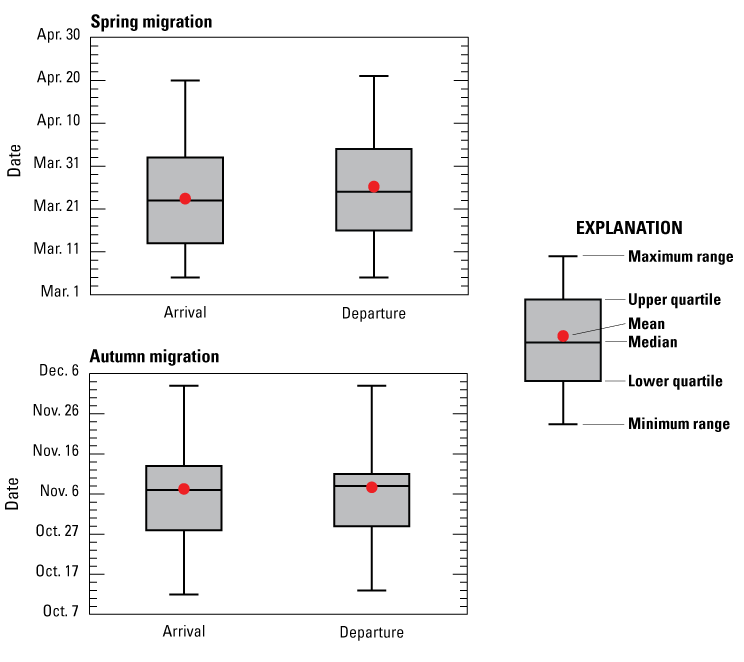
Box plots showing arrival and departure dates of Grus americana (Linnaeus, 1758; whooping cranes) migrating into and out of the 25-kilometer buffers surrounding Kegelman Auxiliary Field and Vance Air Force Base during the spring and autumn migrations, 2017–22, Oklahoma.
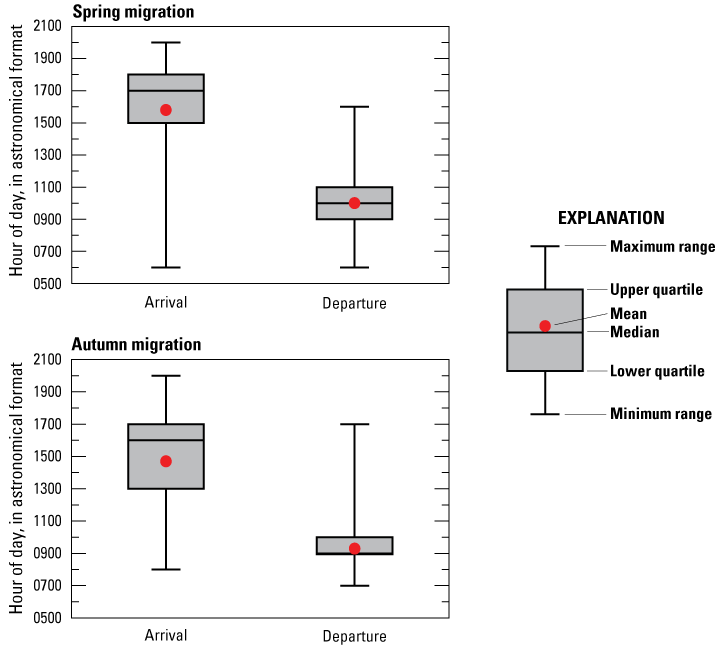
Box plots showing hour of arrival and departure of Grus americana (Linnaeus, 1758; whooping cranes) migrating into and out of the 25-kilometer buffers surrounding Kegelman Auxiliary Field and Vance Air Force Base during the spring and autumn migrations, 2017–22, Oklahoma.
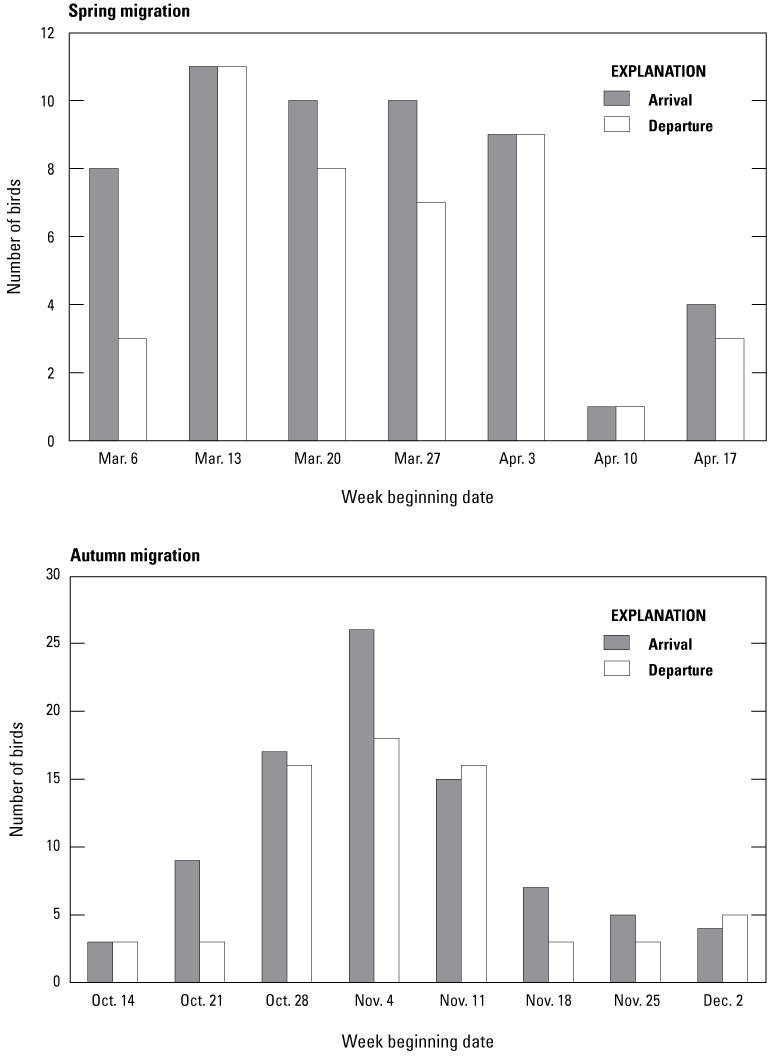
Graphs showing weekly arrival and departure of Grus americana (Linnaeus, 1758; whooping cranes) migrating into and out of the 25-kilometer buffers surrounding Kegelman Auxiliary Field and Vance Air Force Base during the spring and autumn migrations, 2017–22, Oklahoma.
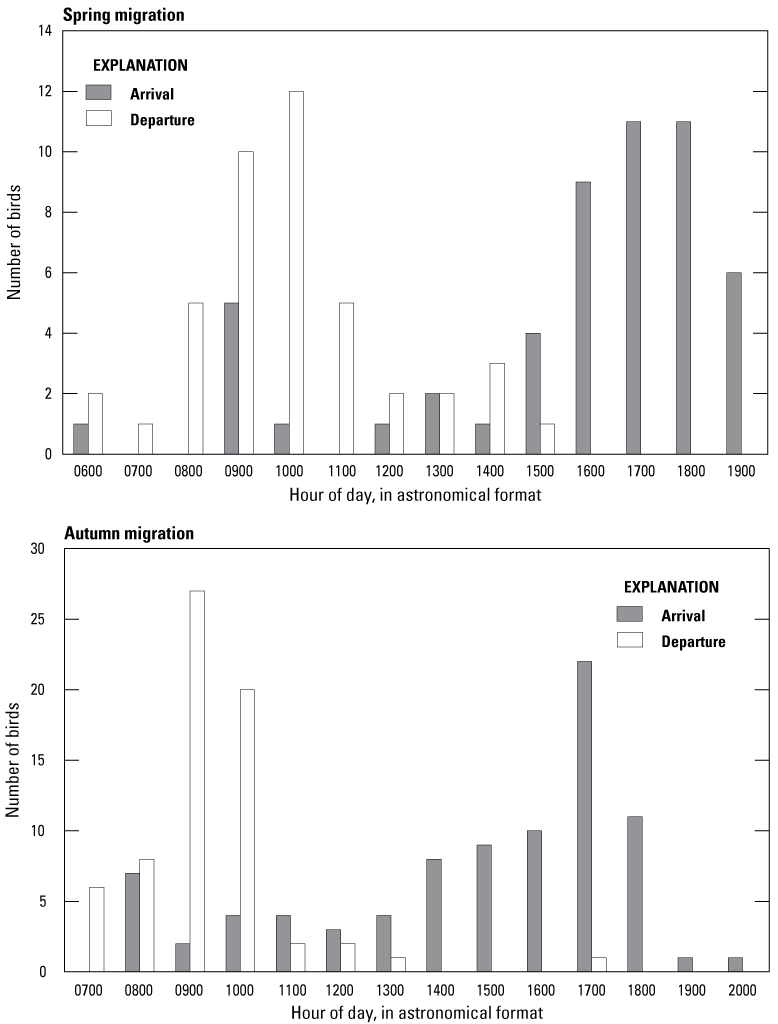
Graphs showing hour of arrival and departure of Grus americana (Linnaeus, 1758; whooping cranes) migrating into and out of the 25-kilometer buffers surrounding Kegelman Auxiliary Field and Vance Air Force Base during the spring and autumn migrations, 2017–22, Oklahoma.
Conversion Factors
Datums
Vertical coordinate information is referenced to the North American Vertical Datum of 1988 (NAVD 88).
Horizontal coordinate information is referenced to the North American Datum of 1983 (NAD 83).
Altitude, as used in this report, refers to distance above the vertical datum.
For more information about this publication, contact:
Director, USGS Northern Prairie Wildlife Research Center
8711 37th Street Southeast
Jamestown, ND 58401
701–253–5500
For additional information, visit: https://www.usgs.gov/centers/npwrc
Publishing support provided by the
Rolla and Baltimore Publishing Service Centers
Disclaimers
Any use of trade, firm, or product names is for descriptive purposes only and does not imply endorsement by the U.S. Government.
Although this information product, for the most part, is in the public domain, it also may contain copyrighted materials as noted in the text. Permission to reproduce copyrighted items must be secured from the copyright owner.
Suggested Citation
Brandt, D.A., and Pearse, A.T., 2024, Migrating whooping crane activity near U.S. Air Force bases and airfields in Oklahoma: U.S. Geological Survey Open-File Report 2024–1056, 23 p., https://doi.org/10.3133/ofr20241056.
ISSN: 2331-1258 (online)
Study Area
| Publication type | Report |
|---|---|
| Publication Subtype | USGS Numbered Series |
| Title | Migrating whooping crane activity near U.S. Air Force bases and airfields in Oklahoma |
| Series title | Open-File Report |
| Series number | 2024-1056 |
| DOI | 10.3133/ofr20241056 |
| Publication Date | September 10, 2024 |
| Year Published | 2024 |
| Language | English |
| Publisher | U.S. Geological Survey |
| Publisher location | Reston, VA |
| Contributing office(s) | Northern Prairie Wildlife Research Center |
| Description | Report: vi, 23 p.; 2 Data Releases |
| Country | United States |
| State | Oklahoma |
| Online Only (Y/N) | Y |
| Additional Online Files (Y/N) | N |


